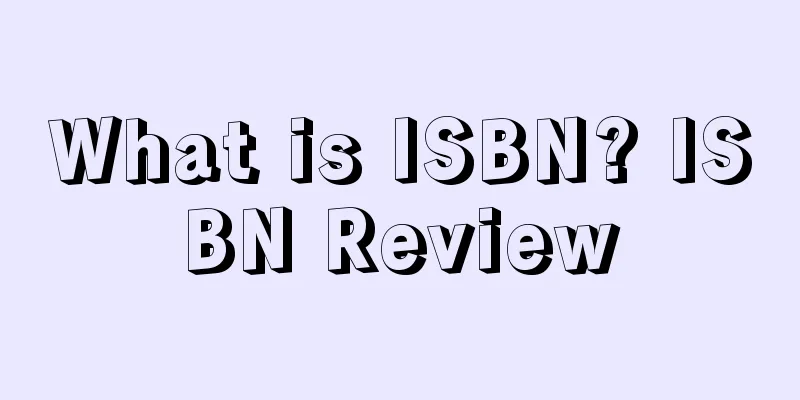What is ISBN? ISBN Review

International Standard Book Number (ISBN) is an international number designed specifically for identifying books and other documents. English International Standard Book Number Chinese International Standard Book Number abbreviation ISBN target publication 10 or 13 digitsOverviewISO promulgated the ISBN international standard in 1972 and established the International ISBN Center, an administrative agency for implementing the standard, at the Prussian Library in West Berlin. Currently, publications using the ISBN coding system include books, pamphlets, microforms, Braille prints, etc. Difference in number segmentsThe International Standard Book Number consists of ten digits, divided into four sections by three dashes, each with a different meaning. The first number segment is the area code, also called the group identifier, which is assigned by the International ISBN Agency (IIA) located in the Staatsbibliothek zu Berlin – Preu?ischer Kulturbesitz in Berlin, Germany. The shortest is one digit, and the longest is five digits, generally taking into account the language, country and region. Countries and regions around the world that voluntarily apply to participate in the International Standard Book Number system are divided into several groups, each with a fixed code, such as 0 and 1 for English publications, 7 for Chinese publications, etc. The second part of the number is the publisher identifier, which is assigned by the national or regional ISBN center to which it belongs, and the allowed value range is 2-5 digits. The larger the publisher is and the more books it publishes, the shorter its number will be. The third part is the title identifier, which is given by the publisher itself. The length of the title identifier of each publisher is fixed. The shortest is one digit and the longest is six digits. The larger the publisher is and the more books it publishes, the longer the title identifier will be. The fourth segment is the check digit, which is calculated by multiplying the first 9 digits of the standard book number by 10 to 2 and then taking 11 as the modulus. The value range is 0-10, with 10 replaced by X. PurposeEvery serial publication with different titles and versions in the world has an internationally unique code identifier. Development HistoryBefore January 1, 2007, the ISBN consisted of 10 digits, divided into four parts: group number (code for country, region, and language), publisher number, book serial number, and check code. The new ISBN was implemented on January 1, 2007. The new ISBN consists of 13 digits divided into five sections, that is, the three-digit EAN (European Article Number [1]) book product code "978" was added to the original 10-digit number. In online catalogs, ISBN can be used as a search field, thus providing users with an additional search method. ExampleChina relatedIn 1982, China joined the ISBN system and established the China ISBN Center (located in the State Press and Publication Administration). The China Standard Book Number was implemented on January 1, 1987, and completely replaced the original unified book number on January 1, 1988. The China Standard Book Number is divided into two parts. The first part is the ISBN, which is the main part; the second part is the basic category number and species number of the "Chinese Library Book Classification System". The category number uses the letters of the major categories of the "China Library Classification System". The species number is the serial number of books published by the same publishing house in the same subject category, which is determined by the publishing house. The category number and species number are separated by a dot (?). The first and second parts are arranged in two lines, or they can be separated by a slash and arranged in one line. For example: The ISBN number of the "CALIS Online Cooperative Cataloging Manual" is: 7-301-04815-7/G?626. References
|
<<: What is ioffer? ioffer Review
>>: What is JC Penney? JC Penney Review
Recommend
Big changes to the front end, in-depth analysis of these three new product labels
Amazon often adjusts its rules and policies to con...
Started a business together, but a white lotus girl appeared halfway, and Z's masculinity collapsed! Sellers on the Japanese site, please pay attention!
Today we share the stories and experiences of two...
Teach you how to boost sales!
NO.1 Use Amazon FBA Using FBA for delivery can ge...
The first quarter of the year saw a huge profit of 3.6 billion yuan, and the grassroots founder became a billionaire
In the golden autumn of October, the big sales are...
How to increase conversion rate of new products on Amazon
Amazon's survival model is nothing more than t...
What is DIN? DIN Review
DIN is the German standardization authority. As a ...
Home Depot's Black Friday sale ranks first in terms of attention, but Amazon is not even on the list!
<span data-shimo-docs="[[20,"获悉,近日,根据金融信息网...
What is Manual Targeting? Manual Targeting Review
Manual Targeting is Amazon’s manual advertising. I...
Too rampant! The seller warned the copycat seller, but was reported and the link was removed!
Amazon's follow-up rules allow buyers to compa...
What is Keywords Everywhere? Keywords Everywhere Review
The Keywords Everywhere extension is a free keywor...
If sellers encounter large-scale associations again, the solutions are here!
Today is Double Eleven But today is not just Doubl...
The autumn sale is coming, but it will trigger a ban crisis?
During the Mid-Autumn Festival and National Day ho...
What is Amazon for Teens? Amazon for Teens Review
Amazon has launched a youth shopping program calle...
What is a classification tree? Classification tree evaluation
On any shopping website (Amazon/eBay/AliExpress, e...
What is Shopping Actions? Shopping Actions Review
On March 21, Google announced a new plan called &q...









